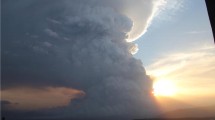Abstract
We analyze and model the structure of spatio-temporal wildfire ignitions in the St. Johns River Water Management District in northeastern Florida. Previous studies, based on the K-function and an assumption of homogeneity, have shown that wildfire events occur in clusters. We revisit this analysis based on an inhomogeneous K-function and argue that clustering is less important than initially thought. We also use K-cross functions to study multitype point patterns, both under homogeneity and inhomogeneity assumptions, and reach similar conclusions as above regarding the amount of clustering. Of particular interest is our finding that prescribed burns seem not to reduce significantly the occurrence of wildfires in the current or subsequent year over this large geographical region. Finally, we describe various point pattern models for the location of wildfires and investigate their adequacy by means of recent residual diagnostics.
Similar content being viewed by others
References
Agee JK (2003) Monitoring postfire tree mortality in mixed-conifer forests of Crater Lake, Oregon. Nat Areas J 23: 114–120
Baddeley A, Møller J, Waagepetersen R (2000) Non- and semi-parametric estimation of interaction in inhomogeneous point patterns. Stat Neerl 54: 329–350
Baddeley A, Turner R (2000) Practical maximum pseudolikelihood for spatial point patterns (with discussion). Aust N Z J Stat 42: 283–322
Baddeley A, Turner R (2005) Spatstat: an R package for analyzing spatial point patterns. J Stat Softw 12: 1–42
Baddeley A, Turner R, Møller J, Hazelton M (2005) Residual analysis for spatial point processes (with discussion). J Roy Stat Soc Ser B 67: 617–666
Brose P, Wade DD (2002) Potential fire behavior in pine flatwood forests following three different fuel reduction techniques. For Ecol Manage 163: 71–84
Butry DT, Gumpertz ML, Genton MG (2008) The production of large and small wildfires. Chapter 5. In: Holmes TP, Prestemon JP, , (eds) Economics of forest disturbances: wildfires, storms, and invasive species. Springer, Dordrecht, The Netherlands
Diggle PJ (1983) Statistical analysis of spatial point patterns. Academic Press, London
Diggle PJ (1985) A kernel method for smoothing point process data. Appl Stat 34: 138–147
Genton MG, Butry DT, Gumpertz ML, Prestemon JP (2006) Spatio-temporal analysis of wildfire ignitions in the St. Johns River Water Management District, Florida. Int J Wildland Fire 15: 87–97
Geyer CJ (1999) Likelihood inference for spatial point processes. Chapter 3. In: Barndorff-Nielsen OE, Kendall WS, Van Lieshout MNM (eds) Stochastic geometry: likelihood and computation. Chapman and Hall/CRC, Monographs on Statistics and Applied Probability, 80:79–140
Haines TK, Busby RL, Cleaves DA (2001) Prescribed burning in the south: trends, purpose, and barriers. South J Appl Forest 25: 149–153
Møller J, Waagepetersen R (2003) Statistical inference and simulation for spatial point processes. Chapman and Hall, Boca Raton
Outcalt KW, Wade DD (2004) Fuels management reduces tree mortality from wildfires in southeastern United States. South J Appl Forest 28: 28–34
Podur J, Martell DL, Csillag F (2003) Spatial patterns of lightning-caused forest fires in Ontario, 1976–1998. Ecol Modell 164: 1–20
Prestemon JP, Pye JM, Butry DT, Holmes TP, Mercer DE (2002) Understanding wildfire risks in a human-dominated landscape. For Sci 48: 685–693
Ripley BD (1977) Modelling spatial patterns (with discussion). J Roy Stat Soc Ser B 39: 172–
Ripley BD (1981) Spatial statistics. Wiley, New York
Schabenberger O, Gotway CA (2005) Statistical methods for spatial data analysis. Chapman and Hall, Boca Raton
Author information
Authors and Affiliations
Corresponding author
Rights and permissions
About this article
Cite this article
Hering, A.S., Bell, C.L. & Genton, M.G. Modeling spatio-temporal wildfire ignition point patterns. Environ Ecol Stat 16, 225–250 (2009). https://doi.org/10.1007/s10651-007-0080-6
Received:
Revised:
Published:
Issue Date:
DOI: https://doi.org/10.1007/s10651-007-0080-6




